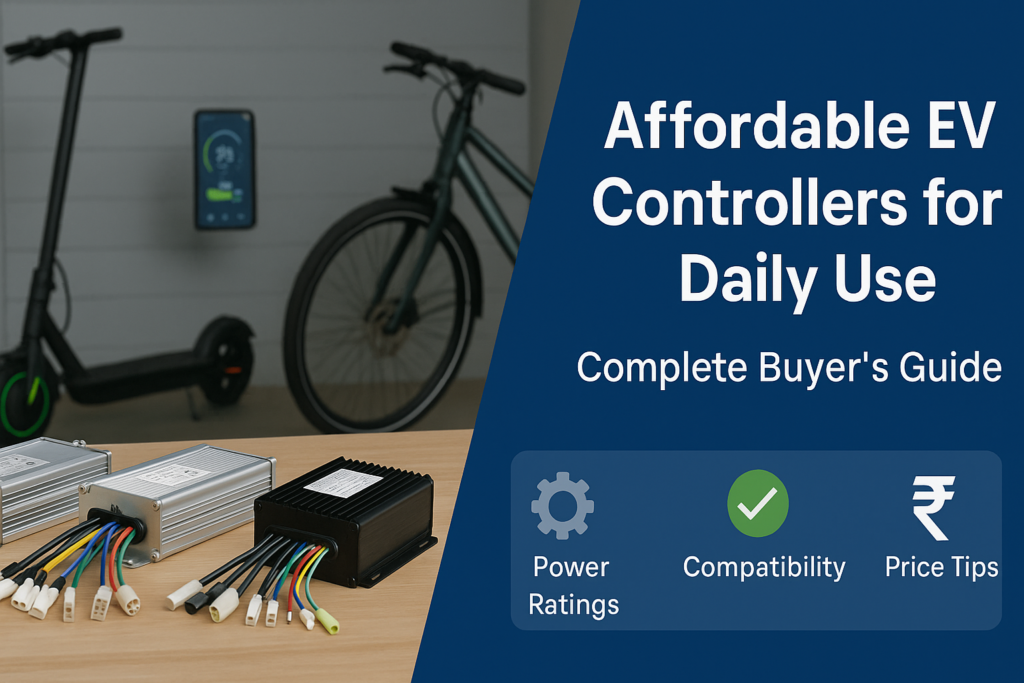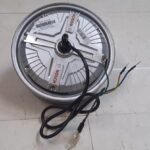
If you’re riding your electric scooter or EV bike daily, having a reliable and budget-friendly controller is essential. The controller acts as the brain of your electric vehicle, managing current flow from the battery to the motor and interpreting signals from the throttle, brake sensors, and display.
Whether you’re replacing a damaged unit or upgrading for better performance, selecting the right affordable EV controller can make a big difference in your ride quality, range, and motor response.
In this blog, we’ll walk through how to choose the best budget controller for daily commuting use, what features to prioritize, and which models to avoid.
What Is an EV Controller?
An EV controller is an electronic component that regulates power from your battery to the motor. It ensures that the motor responds accurately to throttle input and brake commands. Without a functioning controller, the scooter won’t accelerate, brake regeneration won’t activate, and other components like displays or headlights may not function properly.
Why Focus on Affordable Controllers?
- Daily riders don’t always need racing-grade high-end controllers.
- Budget-friendly controllers work great for 250W–1000W setups.
- Easy to replace without heavy tools or complex installation.
- Perfect for city commuting, delivery riders, or college students.
Key Features to Look for in a Budget EV Controller
1. Voltage & Wattage Compatibility
Check if your scooter battery is 48V, 60V, or 72V. Then match the wattage (250W, 350W, 500W, 1000W).
- For 48V 500W setup → Get a 48V 500W controller
- For 60V 1000W setup → Choose a 60V 1000W controller
2. Motor Compatibility (BLDC vs PMSM)
Most Indian EV scooters use BLDC motors. Ensure the controller is:
- BLDC-compatible (3-phase wires + Hall sensor connector)
- Square wave or sine wave (depending on your riding smoothness preference)
Sine wave = smoother ride
Square wave = slightly rougher, but cheaper
3. Connector Type
Your controller should match:
- Throttle connectors (2-pin or 3-pin)
- Motor phase wires (yellow, blue, green)
- Battery input (red & black terminals)
- Brake sensor (low or high brake)
- Speedometer/display (if applicable)
Always check connector pin style to avoid rewiring.
Common Affordable Controllers by Voltage
48V 500W Controller
- Great for college or office commute
- Compact, lightweight
- Compatible with most 48V scooters
- Price: ₹800 – ₹1300
60V 1000W Controller
- Better torque for hilly areas
- Supports heavier scooters
- Works with larger batteries
- Price: ₹1100 – ₹1800
Buy Now:
Shop All Controllers
Which Controller Is Right for Your Usage?
| Use Case | Suggested Controller Specs |
| City Commuting | 48V 500W square wave controller |
| Light Cargo Delivery | 60V 1000W square wave controller |
| Hills or Extra Load | 60V 1000W sine wave controller |
| Student Scooter | 48V 350W controller with smart cut-off |
Budget-Friendly EV Controllers Available at ElectricScootersParts.in
1. 48V 500W BLDC Square Wave Controller
- Durable, efficient
- Works with lead-acid or lithium setups
- Best for Hero Electric, Ampere Magnus, etc.
2. 60V 1000W Sine Wave Controller
- Better pickup and smooth performance
- For longer-range e-scooters
3. 48V 350W Compact Controller
- Super compact, ideal for light scooters
How to Install a Controller (Quick Steps)
- Turn off scooter and remove battery.
- Locate the old controller near the battery or under the seat.
- Disconnect throttle, motor, brake, and battery wires.
- Mount new controller securely using screws or tie clamps.
- Reconnect wires by color code.
- Test all functions before final ride.
Need help with motor upgrades too?
👉 Read How to Upgrade Your Electric Scooter Motor Safely
Troubleshooting Budget Controllers
Problem: Motor not turning
Fix: Check Hall sensor connector, battery voltage
Problem: Sudden jerks or throttle lag
Fix: Replace or calibrate throttle pin connection
Problem: No response to throttle
Fix: Controller may be locked, check brake override wires
Safety Tips When Using Affordable Controllers
- Never over-amp a cheap controller; it may overheat
- Always keep wires covered from water or dust
- Don’t use low brake and high brake inputs at the same time
- Avoid pairing high-power motors with under-rated controllers
Related Blogs
- Choosing the Right Motor Kit for Your Electric Scooter
- Top 5 EV Spare Parts You Must Carry While Riding
- Affordable EV Chargers for Daily Use
- How to Identify a Failing EV Battery
Get the Best Controller at the Best Price
Daily riders deserve reliable performance without spending thousands. Whether you want to replace a broken controller or upgrade to a more responsive unit, explore affordable options tailored to your EV.
Shop all verified EV controllers now → Electric Scooter Controllers
FAQs – EV Controller Edition
Q. Can I use a 1000W controller with a 500W motor?
Technically yes, but it may reduce efficiency or strain the motor.
Q. How do I know if my controller is BLDC compatible?
It will have 3 motor phase wires (Yellow, Blue, Green) and Hall sensor connectors.
Q. Are square wave controllers bad?
Not at all. They are cost-effective and work well for daily riding.
Q. Do I need to change the throttle when changing the controller?
Only if the new controller uses a different throttle pin setup.





